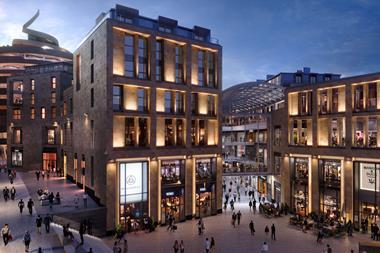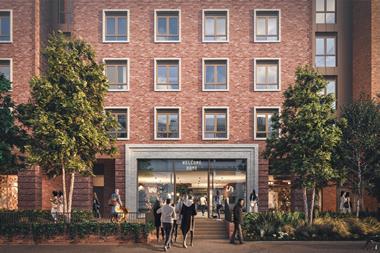Development largely disappeared in the wake of the recession and remains subdued. What will be the characteristics of those schemes that get off the ground? Tim Danaher reports

The centre of Leeds is being transformed as Trinity Leeds, a 1 million sq ft development by Land Securities, takes shape in the Yorkshire city. Anchored by retailers including Next, Topshop, River Island and Hollister, it is the type of scheme that has transformed many of the UK’s cities over the past decade.
From Aberdeen to Plymouth – via plenty of places in between – the UK’s city centres have been transformed during the noughties by quality developments built to satisfy the high level of demand from retailers for city centre units of the right size and configuration.
Leeds is just the latest of this type of scheme. But something’s changed. Following the recent opening of Westfield Stratford City two weeks ago, Leeds is the only major city centre development of any real scale taking place in the UK right now.
There’s plenty of talk about development returning, but what evidence is there that the development market really is open for business again? And what are the characteristics of those schemes that will make it off the drawing board and actually start coming out of the ground in the months ahead?
A new model
What became very clear during the recession is that in today’s world of subdued retailer demand the existing model of schemes anchored by a massive department store paying little if no rent is now much harder to stand up. Leeds is a one-off in that it is a top five city, which has been underserved by retail for many years, and the scheme was ready to come off ice just as soon as the recession thawed.
For other schemes, the case will be less clear cut. While they will always want a presence in the heart of the biggest cities, most retailers now need fewer stores than in the past, and many are trying to trim rather than grow their estates.
“In general, there isn’t much development going on,” says British Land head of retail Charles Maudsley. “There are very few organisations, that meet the three or four key requirements of having the land, the development finance, the development skills and the retailer relationships to de-risk the scheme enough to start on site.”
But that’s not to say that they won’t be happening – rather than they will take a different shape to those we saw five years ago. “The scale has changed hugely,” says Alistair Shaw, director of developer Stanhope, which is pressing ahead with an £80m, 300,000 sq ft development in the centre of Hereford.
Hereford benefits from being a captive market for its large rural catchment – it’s an hour’s drive from any major shopping destination and Shaw says the quality of the roads out means that can easily become an hour-and-a-half if the traffic is bad. But even here plans have had to change to reflect the market. “Even cities like Hereford thought they needed 450,000 to 500,000 sq ft but these schemes are now going to be no more than 300,000 sq ft. It’s very important that these schemes don’t overwhelm what already exists.”
Smaller schemes not only cater for the new reality of lower retail demand, but also are more attractive to funding institutions by creating investments of less than £100m in value, which can attract more than just the biggest investors.
But the changes aren’t just going to be about the size of the schemes. Lawrence Hutchings, managing director of UK retail at Hammerson, says that the nature of the developments of the future will be changing too. “We’ve taken the opportunity over the last couple of years to review all our plans. We’ve been looking at whether they were the product of a former era when we thought that growth in consumer spending would be endless.
“We went back to our retailer customers and asked whether they would want more space or less space, and what the multichannel world means for their requirements. And we also looked at the efficiency of the schemes – are they efficient in their use of space, does it represent best practice, is it what our customers want?”
This means taking some very practical considerations into account – for example, designing space around optimum column grids so that space can be used in whatever permutation is most appropriate for current retail demand – but it also means looking at how customers are shopping and what they’re looking for from a day at the shops.
Leisurely experience
Leisure is sure to play a much bigger part. There has been a sea change in how the role of leisure in a shopping centre is perceived. “In the past, leisure was thought to be an add-on to shopping – now shopping is a leisure experience,” says Hutchings.
A much higher percentage of space is being given over to leisure uses, whether they be catering, cinemas or the new generation of bowling alleys. Whereas in the past a typical shopping centre might have had 4% of its space devoted to leisure, in the future that might be as much as 10%. Equally important is the setting for the restaurants and leisure, which increasingly will be a vital part of the mall rather than on the fringe of the centre.
Making schemes stack up financially is still a challenge, and many large-scale projects that have been on the blocks for years remain stalled. “You’ve got quite a few schemes where a lot of work has been done – Preston, Crawley, Stevenage, Bracknell – which haven’t gone away, it’s just a question of making them add up,” says Alistair Parker, partner at Cushman & Wakefield.
At two of those schemes – Preston and Crawley – John Lewis had agreed terms to be the anchor tenant. The department store was a beneficiary of the development boom, with its status as an anchor tenant enabling it to secure advantageous terms as developers knew it would attract other tenants.
John Lewis has adapted its property criteria to reflect the new order. It is now prepared to be more flexible on store sizes – as it has in Exeter where it is opening a smaller department store format in a building owned by Land Securities.
In addition, says Hutchings, department stores are being more efficient with their usage of space. Previously, department store operators have used as much as 45% of their floorspace as storage but he says they are now asking themselves if this is an efficient use of space.
John Lewis has needed to take its new approach as the number of big schemes in the pipeline remains low and while experts vary on the extent to which they believe development is returning, no one expects it to return to the heady levels of 2007 and 2008.
So for many in the retail community, the development activity will focus on smaller schemes, often anchored by food stores, or adding additional space for larger fashion retailers to existing schemes.
“Despite the tough market, we see a continued demand for edge-of-town opportunities from strong retailers as they’re looking for the right space and place to grow,” says Land Securities head of retail development Lester Hampson. “In the short to medium term, we have identified a £275m, 1 million sq ft pipeline of projects to satisfy this demand. These schemes will boost local economies and create over a 1,000 jobs.”
Maudsley agrees that these are the type of projects that are more likely to see the light of day. “We’re proactively looking for schemes at the moment. They’re more likely to be edge of town big box rather than town centre schemes. In today’s market, how many people can take on a project with a four to five year time horizon?”
These might not be the 1 million sq ft giants that we became used to in the past decade, but are increasingly likely to represent the type of developments that meet retailers’ requirements in the multichannel age. What’s more, they will also carve out a new future for the second tier of retail locations, giving them sustainable schemes, which complement rather than detract from the existing retail offer.


























No comments yet